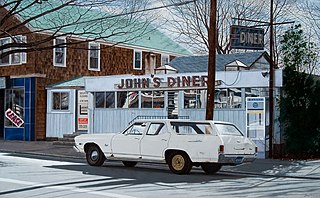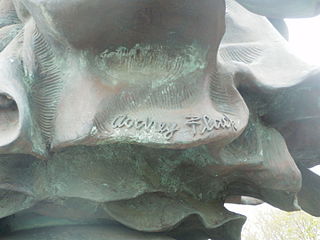
Visual art of the United States or American art is visual art made in the United States or by U.S. artists. Before colonization there were many flourishing traditions of Native American art, and where the Spanish colonized Spanish Colonial architecture and the accompanying styles in other media were quickly in place. Early colonial art on the East Coast initially relied on artists from Europe, with John White the earliest example. In the late 18th and early 19th centuries, artists primarily painted portraits, and some landscapes in a style based mainly on English painting. Furniture-makers imitating English styles and similar craftsmen were also established in the major cities, but in the English colonies, locally made pottery remained resolutely utilitarian until the 19th century, with fancy products imported.

Photorealism is a genre of art that encompasses painting, drawing and other graphic media, in which an artist studies a photograph and then attempts to reproduce the image as realistically as possible in another medium. Although the term can be used broadly to describe artworks in many different media, it is also used to refer specifically to a group of paintings and painters of the American art movement that began in the late 1960s and early 1970s.

Robert William Vonnoh was an American Impressionist painter known for his portraits and landscapes. He traveled extensively between the American East Coast and France, more specifically the artists colony Grez-sur-Loing.

Audrey L. Flack is an American artist. Her work pioneered the art genre of photorealism and encompasses painting, sculpture, and photography.

Soren Emil Carlsen was an American Impressionist painter who emigrated to the United States from Denmark. He became known for his still lifes. Later in his career, Carlsen expanded his range of subjects to include landscapes and seascapes as well.

Classical Realism is an artistic movement in the late-20th and early 21st century in which drawing and painting place a high value upon skill and beauty, combining elements of 19th-century neoclassicism and realism.
Idelle Lois Weber was an American artist most closely aligned with the Pop art and Photorealist movements.
Robert Neffson is an American painter known for his photorealistic street scenes of various cities around the world, museum interiors and for early still lifes and figure paintings.
Lowell Blair Nesbitt was an American painter, draughtsman, printmaker, and sculptor. He served as the official artist for the NASA Apollo 9, and Apollo 13 space missions; in 1976 the United States Navy commissioned him to paint a mural in the administration building on Treasure Island spanning 26 feet x 251 feet, then the largest mural in the United States; and in 1980 the United States Postal Service honored Lowell Nesbitt by issuing four postage stamps depicting his paintings.
Timothy J. Clark is an American artist best known for his large watercolor paintings of urban landscapes, still lifes, and interiors, and for his oil and watercolor portraits. His paintings and drawings are in the permanent collections of more than twenty art museums.

Janet Fish is a contemporary American realist artist. Through oil painting, lithography, and screenprinting, she explores the interaction of light with everyday objects in the still life genre. Many of her paintings include elements of transparency, reflected light, and multiple overlapping patterns depicted in bold, high color values. She has been credited with revitalizing the still life genre.
Robert Cottingham is an American artist known for his paintings and prints of urban American landscapes showing building facades, neon signs, movie marquees, railroad heralds and shop fronts.
The contemporary realism movement is a worldwide style of painting which came into existence c. 1960s and early 1970s. Featuring a straightforward approach to representation practiced by artists such as Philip Pearlstein, Alex Katz, Jack Beal and Neil Welliver. The movement refers to figurative art works created in a natural yet highly objective style. Today the term Contemporary Realism encompasses all post-1970 sculptors and painters whose discipline is representational art, where the object is to portray the "real" and not the "ideal".
Maxwell Hendler is an American painter. In 1975, he became the first contemporary artist to have pictures in the collection of the Metropolitan Museum of Art in New York.

Stephen Scott Young is an American artist best known for his watercolor paintings and etchings that depict everyday life on the east coast of the United States and the Out Islands of The Bahamas. Often painting genre scenes of quotidian life, Young's work is noted for his strikingly realist use of watercolor and eloquent simplicity of subject matter done in the American realist tradition. Young's copperplate etchings evidence a strident attention to detail and intricacy that suggest the influence of Rembrandt and Whistler. Though the images he creates are often nostalgic, his work deals with contemporary issues. Art historian Henry Adams wrote of Young in the late 1980s: "He is like one of those prospectors who has gone back to the tailings of an abandoned mine and where others saw only useless rocks found quantities of untapped, undiscovered gold." He has been exhibited nationally and internationally, and has work in major American museums, including the Cleveland Museum of Art, the Greenville County Museum of Art, and the Kemper Museum of Contemporary Art.
John Baeder is an American painter closely associated with the Photorealist movement. He is best known for his detailed paintings of American roadside diners and eateries.
William L. Haney is recognized for his narrative-realist paintings. His paintings were constructed as conceptual collages involving social-political issues of the late 20th century. Haney was intensely engaged in art history, often referencing other artists and the world around him. His artistic process consisted of drawing and collecting images from magazines, posters, and other sources. Usually, he would prepare watercolor first and then plan placement as per color attributes, finishing with an oil painting and print. His draftsman skills only allowed him to draw on canvas without the aid of a camera. He was also known as a super-realist and a post photo-realist. Other contemporary painters working in a super-realistic or hyper-realistic style are Richard Estes and Robert Birmelin.

Realism was an artistic movement that emerged in France in the 1840s, around the 1848 Revolution. Realists rejected Romanticism, which had dominated French literature and art since the early 19th century. Realism revolted against the exotic subject matter and the exaggerated emotionalism and drama of the Romantic movement. Instead, it sought to portray real and typical contemporary people and situations with truth and accuracy, and not avoiding unpleasant or sordid aspects of life. The movement aimed to focus on unidealized subjects and events that were previously rejected in art work. Realist works depicted people of all classes in situations that arise in ordinary life, and often reflected the changes brought by the Industrial and Commercial Revolutions. Realism was primarily concerned with how things appeared to the eye, rather than containing ideal representations of the world. The popularity of such "realistic" works grew with the introduction of photography—a new visual source that created a desire for people to produce representations which look objectively real.

David T. Kessler is an American artist primarily known for his photo-realist paintings. Although he is a longtime resident of Phoenix, Arizona, Kessler launched his career in San Francisco in the mid 1970s, at a time when a significant school of photo-realism was emerging in the Bay Area.
Sidney Goodman was an American figurative painter and draftsman from Philadelphia, PA who explored the human form. Goodman received public notice in the early 1960s for his oil paintings, leading to his inclusion in the 1973 Whitney Biennial. In 1996, the Philadelphia Museum of Art presented a retrospective show of Goodman's paintings and drawings.












